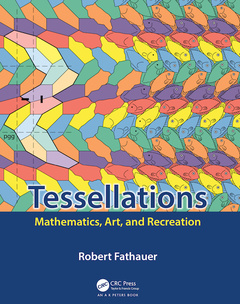Description
Tessellations
Mathematics, Art, and Recreation
AK Peters/CRC Recreational Mathematics Series
Author: Fathauer Robert
Language: English
Subject for Tessellations:
Keywords
Regular Tessellation; Contains tutorial content on designing and drawing Escheresque tessellations; Rotational Symmetry; Filled with templates to aid in creating Escheresque tessellations; Two-fold Rotational Symmetry; Highlights numerous examples of tessellations in the real world; Equilateral Triangle; Activities for individuals or classes; Regular Polygons; Treats special topics like spiral and fractal tessellations; Interior Details; Escheresque designs; Counter-clockwise; Escheresque tessellations; Glide Reflection; Polyhedra; Four-fold Rotational Symmetry; Tessellation metamorphoses; Two-fold Rotational; Tessellations; Three-fold Rotational Symmetry; Rhombic Triacontahedron; Mirror Symmetry; Craft Knife; Convex Polyhedron; Spherical Tessellation; Archimedean Solids; Polygonal Tile; Regular Hexagon; Form Line; Small Rhombicuboctahedron; Tile Grids; Translational Symmetry; Horned Lizard; Symmetry Group
Publication date: 10-2020
· 20.3x25.4 cm · Paperback
Publication date: 10-2020
· 20.3x25.4 cm · Hardback
Description
/li>Contents
/li>Readership
/li>Biography
/li>
Tessellations: Mathematics, Art and Recreation aims to present a comprehensive introduction to tessellations (tiling) at a level accessible to non-specialists. Additionally, it covers techniques, tips, and templates to facilitate the creation of mathematical art based on tessellations. Inclusion of special topics like spiral tilings and tessellation metamorphoses allows the reader to explore beautiful and entertaining math and art.
The book has a particular focus on ?Escheresque? designs, in which the individual tiles are recognizable real-world motifs. These are extremely popular with students and math hobbyists but are typically very challenging to execute. Techniques demonstrated in the book are aimed at making these designs more achievable. Going beyond planar designs, the book contains numerous nets of polyhedra and templates for applying Escheresque designs to them.
Activities and worksheets are spread throughout the book, and examples of real-world tessellations are also provided.
Key features
- Introduces the mathematics of tessellations, including symmetry
- Covers polygonal, aperiodic, and non-Euclidean tilings
- Contains tutorial content on designing and drawing Escheresque tessellations
- Highlights numerous examples of tessellations in the real world
- Activities for individuals or classes
- Filled with templates to aid in creating Escheresque tessellations
- Treats special topics like tiling rosettes, fractal tessellations, and decoration of tiles
1. Introduction to Tessellations. 2. Geometric Tessellations. 3. Symmetry and Transformations in Tessellations. 4. Tessellations in Nature. 5. Decorative and Utilitarian Tessellations. 6. Polyforms and Reptiles. 7. Rosettes and Spirals. 8. Matching Rules, Aperiodic Tiles, and Substitution Tilings. 9. Fractal Tiles and Fractal Tilings. 10. Non-Euclidean Tessellations. 11. Tips on Designing and Drawing Escheresque Tessellations. 12. Special Techniques to Solve Design Problems. 13. Escheresque Tessellations Based on Squares. 14. Escheresque Tessellations Based on Isosceles Right Triangle and Kite-Shaped Tiles. 15. Escheresque Tessellations Based on Equilateral Triangle Tiles. 16. Escheresque Tessellations Based on 60°–120° Rhombus Tiles. 17. Escheresque Tessellations Based on Hexagonal Tiles. 18. Decorating Tiles to Create Knots and Other Designs. 19. Tessellation Metamorphoses and Dissections. 20. Introduction to Polyhedra. 21. Adapting Plane Tessellations to Polyhedra. 22. Tessellating the Platonic Solids. 23. Tessellating the Archimedean Solids. 24. Tessellating Other Polyhedra. 25. Tessellating Other Surfaces.
Robert Fathauer has had a life-long interest in art but studied physics and mathematics in college, going on to earn a PhD from Cornell University in electrical engineering. For several years he was a researcher at the Jet Propulsion Laboratory in Pasadena, California. Long a fan of M.C. Escher, he began designing his own tessellations with lifelike motifs in the late 1980s. In 1993, he founded a business, Tessellations, to produce puzzles based on his designs. Over time, Tessellations has grown to include mathematics manipulatives, polyhedral dice, and books.
Dr. Fathauer’s mathematical art has always been coupled with recreational math explorations. These include Escheresque tessellations, fractal tilings, and iterated knots. After many years of creating two-dimensional art, he has recently been building ceramic sculptures inspired by both mathematics and biological forms. Another interest of his is photographing mathematics in natural and synthetic objects, particularly tessellations. In addition to creating mathematical art, he’s strongly committed to promoting it through group exhibitions at both the Bridges Conference and the Joint Mathematics Meetings.




